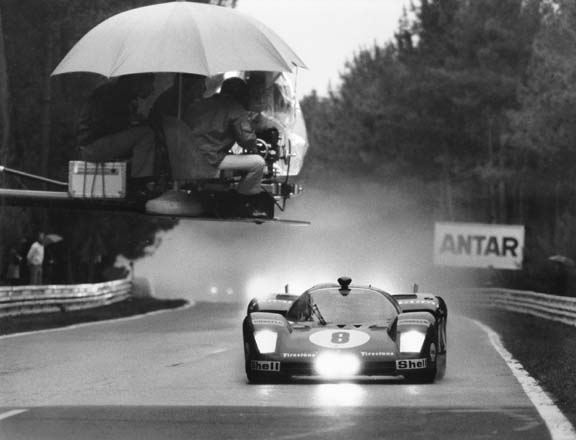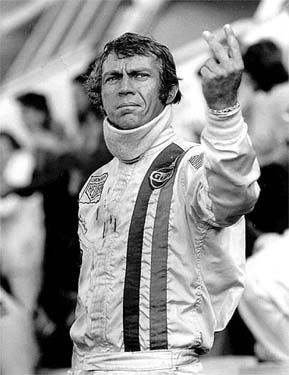
|
|




At The Movie - Part 2 |
By Mike Twite (CAR December 1970) The cost of setting up the operation runs into many millions of dollars - no one is quite certain just how much - but Solar Productions reckons to have spent four million dollars in the Le Mans area alone. The main problem was getting the use of the circuit, which uses a lot of normal public roads and runs past many houses, restaurants, factories, etc. The avaricious Automobile Club de L'Ouest and the Departement de la Sarthe were convinced that it would be a good idea to hire out the track, especially when Solar offered a 30.000 dollar fee! Another 30.000 dollar was spent on building the Solar village inside the circuit, this consists of a huge dining hall, offices, workshops, toilets, dormitories, and caravans, together with practically every facility that might be needed by the crew. Anything between 150 to 300 people are working on the film at any one time, plus up to 1000 extras in the crowd scenes. The huge 75mm Panavision cameras are hired from a London firm at astronomical cost and consume film at a horrifying rate, especially during the slow motion sequences. Perhaps the most expensive undertaking was to assemble the 25-car selection of sports cars and their drivers. There were four Ferraris, five Porsche 917s, three Porsche 908s, two Lolas, two Chevrons, four POrsche 911s, a Matra, a Ferrari 312, a GT40, a Porsche 914 and an Alfa Romeo 33. These were all assembled by ex-Lotus team manager Andrew Ferguson and kept running under appalling conditions by a team of mechanics who were housed in a huge garage owned by a caravan firm. The cars, most of which had got through the real Le mans, had to do day after day of stop-start motoring over a three-month period. Surprisingly there were few breakdowns. The real drivers commuted back and forth from their various racing commitments, but the cars usually stayed at Le Mans, their owners suitably compensated for the loss of racing miles. The drivers, who were paid a minimum of 200 dollars (£80) a day, varied their time between hurtling down the Mulsanne Straight at 180 mph and sitting in their caravan playing chess, reading and getting thoroughly bored. In fact the big problem in film making is the time taken to set up a scene, which involves only a few people in the lighting, sound and camera departments. Everyone else stands around feeling completely useless. Two of the drivers actually get small parts in the film; Jonathan Williams plays Jonathan Burton, co-driver of Ferrari no. 5, and Eric Glavitza, the austrian rally and racing driver, plays Joseph Hauser, co-driver of Ferrari no. 8. |
Delaney asks for two more cup of coffee - we think! |
Apart from McQueens few people will have heardof any of the other actors in the film, who seem to have been deliberately chosen for their anonymity. The only well known British actor is Ronald Leigh-Hunt, who plays the part of JWs team manager. Being a real professinal he earned the accolade from one mechanic "He's more like David Yorke than David Yorke is!" So dedicated is he to his part that he even eats with the mechanics at his hotel in Le Mans. One or two af the actors over-act like mad both on and off the set, which I hope does not show through the film. Gino Cassani, who plays the Ferrari team manager, seemed most unconvincing to my inexpert eye but at least he showed a fine turn of speed when an airline blew off its pipe in the pits. While everyone else stared curiously, Cassani was hotfooting it down the pit lane. What was that joke about the book of Italian heores? Everyone in the crew has some story or other to tell of his exploits. British sound engineer John Mitchell had to sit in the passenger seat of a 917 next to Rob Slotemaker while he hurtled down theMulsanne Straight to record the noise of a Porsche on full song, and worst of all he had to record Slotemaker spinning the Porsche on a wet track. The cameramen who have had to sit in the jump seat of the special cut down GT40, and in cradles outrigged behind 917s, all have their tales to tell, but I can't repeat them as most of the camera crew are French, the chief cameramean being Rene Guissart, who filmed Grand Prix. I won't spoil things by telling you the story of the film - it might change between now and next June anyway! However, Steve McQueen doesn't win the race after all and he doesn't get to kiss the leading lady. All I can say is that thsi will undoubtedly be the finest movie about motor racing yet seen. The shots taken from the Porsche 908 which took part in the race driven by Jonathan Willaims and Herbert Linge are quite fantastic. Amazingly, had this car been eligible for the race it would have finished eighth overall despite its enormous load of two cameras. They didn't make pit stops for fuel, just new reels of film! The other actionphotography is also some of the best I have seen. You just can't afford to miss it. |
A Ferrari 512S in a racing scene captured by the cameraman |